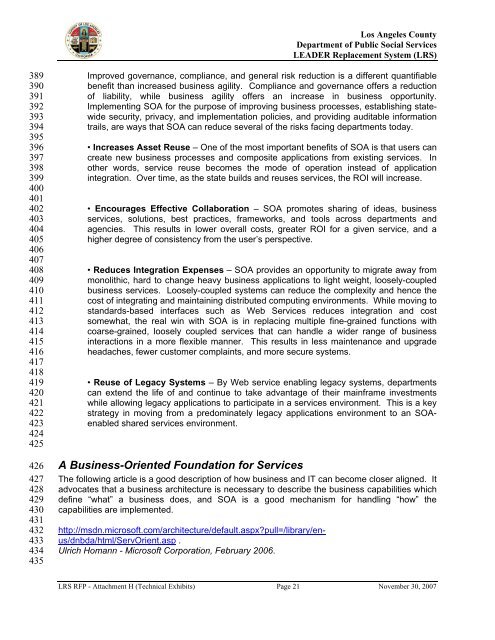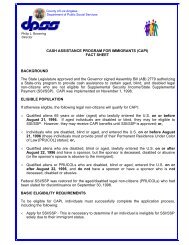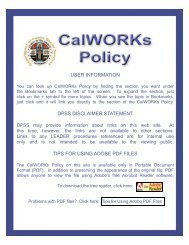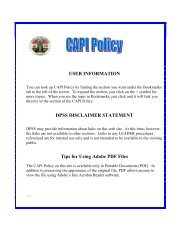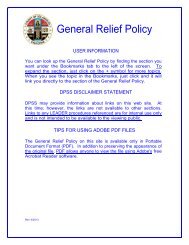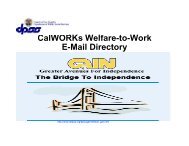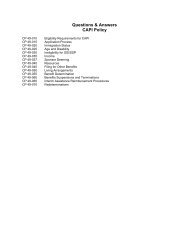leader replacement system - Department of Public Social Services ...
leader replacement system - Department of Public Social Services ...
leader replacement system - Department of Public Social Services ...
Create successful ePaper yourself
Turn your PDF publications into a flip-book with our unique Google optimized e-Paper software.
Los Angeles County<br />
<strong>Department</strong> <strong>of</strong> <strong>Public</strong> <strong>Social</strong> <strong>Services</strong><br />
LEADER Replacement System (LRS)<br />
389<br />
390<br />
391<br />
392<br />
393<br />
394<br />
395<br />
396<br />
397<br />
398<br />
399<br />
400<br />
401<br />
402<br />
403<br />
404<br />
405<br />
406<br />
407<br />
408<br />
409<br />
410<br />
411<br />
412<br />
413<br />
414<br />
415<br />
416<br />
417<br />
418<br />
419<br />
420<br />
421<br />
422<br />
423<br />
424<br />
425<br />
426<br />
427<br />
428<br />
429<br />
430<br />
431<br />
432<br />
433<br />
434<br />
435<br />
A Business-Oriented Foundation for <strong>Services</strong><br />
Improved governance, compliance, and general risk reduction is a different quantifiable<br />
benefit than increased business agility. Compliance and governance <strong>of</strong>fers a reduction<br />
<strong>of</strong> liability, while business agility <strong>of</strong>fers an increase in business opportunity.<br />
Implementing SOA for the purpose <strong>of</strong> improving business processes, establishing statewide<br />
security, privacy, and implementation policies, and providing auditable information<br />
trails, are ways that SOA can reduce several <strong>of</strong> the risks facing departments today.<br />
• Increases Asset Reuse – One <strong>of</strong> the most important benefits <strong>of</strong> SOA is that users can<br />
create new business processes and composite applications from existing services. In<br />
other words, service reuse becomes the mode <strong>of</strong> operation instead <strong>of</strong> application<br />
integration. Over time, as the state builds and reuses services, the ROI will increase.<br />
• Encourages Effective Collaboration – SOA promotes sharing <strong>of</strong> ideas, business<br />
services, solutions, best practices, frameworks, and tools across departments and<br />
agencies. This results in lower overall costs, greater ROI for a given service, and a<br />
higher degree <strong>of</strong> consistency from the user’s perspective.<br />
• Reduces Integration Expenses – SOA provides an opportunity to migrate away from<br />
monolithic, hard to change heavy business applications to light weight, loosely-coupled<br />
business services. Loosely-coupled <strong>system</strong>s can reduce the complexity and hence the<br />
cost <strong>of</strong> integrating and maintaining distributed computing environments. While moving to<br />
standards-based interfaces such as Web <strong>Services</strong> reduces integration and cost<br />
somewhat, the real win with SOA is in replacing multiple fine-grained functions with<br />
coarse-grained, loosely coupled services that can handle a wider range <strong>of</strong> business<br />
interactions in a more flexible manner. This results in less maintenance and upgrade<br />
headaches, fewer customer complaints, and more secure <strong>system</strong>s.<br />
• Reuse <strong>of</strong> Legacy Systems – By Web service enabling legacy <strong>system</strong>s, departments<br />
can extend the life <strong>of</strong> and continue to take advantage <strong>of</strong> their mainframe investments<br />
while allowing legacy applications to participate in a services environment. This is a key<br />
strategy in moving from a predominately legacy applications environment to an SOAenabled<br />
shared services environment.<br />
The following article is a good description <strong>of</strong> how business and IT can become closer aligned. It<br />
advocates that a business architecture is necessary to describe the business capabilities which<br />
define “what” a business does, and SOA is a good mechanism for handling “how” the<br />
capabilities are implemented.<br />
http://msdn.micros<strong>of</strong>t.com/architecture/default.aspx?pull=/library/enus/dnbda/html/ServOrient.asp<br />
.<br />
Ulrich Homann - Micros<strong>of</strong>t Corporation, February 2006.<br />
LRS RFP - Attachment H (Technical Exhibits) Page 21 November 30, 2007


